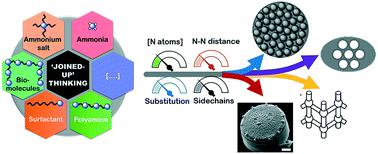当前位置:
X-MOL 学术
›
Mol. Syst. Des. Eng.
›
论文详情
Our official English website, www.x-mol.net, welcomes your
feedback! (Note: you will need to create a separate account there.)
Unified mechanistic interpretation of amine-assisted silica synthesis methods to enable design of more complex materials
Molecular Systems Design & Engineering ( IF 3.2 ) Pub Date : 2021-1-14 , DOI: 10.1039/d0me00131g Joseph R. H. Manning 1, 2, 3, 4, 5 , Carlos Brambila 1, 2, 3, 4, 5 , Siddharth V. Patwardhan 1, 2, 3, 4, 5
Molecular Systems Design & Engineering ( IF 3.2 ) Pub Date : 2021-1-14 , DOI: 10.1039/d0me00131g Joseph R. H. Manning 1, 2, 3, 4, 5 , Carlos Brambila 1, 2, 3, 4, 5 , Siddharth V. Patwardhan 1, 2, 3, 4, 5
Affiliation

|
The design of porous sol–gel silica materials is a thriving research field, owing to silica's diversity of properties and potential applications. Using a variety of additives, most commonly amine-based organic molecules, several families of silica materials have been developed including silica nanospheres, zeolites, mesoporous silicas, and bioinspired silicas with controlled particle and pore morphology on multiple length scales. Despite the wide range of study into these materials, and similarity in terms of reagents and additive compounds, none can recreate the features and complexity present within naturally occurring biosilica materials. This is due in part to a lack of ‘joined-up’ thinking during research into silica synthesis strategies and methodology. Specifically, mechanistic insights gained for one set of conditions or additive structures (i.e. material types) are not translated to other material types. In order to improve the structural complexity available in synthetic silica materials, as well as to improve both understanding and synthesis methods for all silica types, a unified approach to mechanistic understanding of formation in amine-assisted silica synthesis is required. Accordingly, in this review we analyse contemporary investigations into silica synthesis mechanism as a function of (amine) additive structure, analysing how they imprint varying levels of order into the eventual silica structure. We identify four fundamental driving forces through which additives control silica structure during synthesis: (i) controlling rates of silica precursor hydrolysis and condensation; (ii) forming charge-matched adducts with silicate ions in solution; (iii) self-assembling into mesophases to physically template pores; and (iv) confining the location of synthesis into specifically shaped vesicles. We analyse how each of these effects can be controlled as a function of additive structure, and highlight recent developments where multiple effects have been harnessed to form synthetic silica materials with further structural complexity than what was previously possible. Finally, we suggest further avenues of research which will lead to greater understanding of the structure–function relationship between amine additives and final materials, hence leading to more complex and high-value silica and other materials.
中文翻译:

胺辅助二氧化硅合成方法的统一机制解释,可设计更复杂的材料
由于二氧化硅的特性和潜在应用的多样性,多孔溶胶-凝胶二氧化硅材料的设计是一个蓬勃发展的研究领域。使用多种添加剂(最常见的是基于胺的有机分子),已经开发了几类二氧化硅材料,包括二氧化硅纳米球,沸石,中孔二氧化硅和生物启发的二氧化硅,并在多个长度尺度上控制了颗粒和孔的形态。尽管对这些材料进行了广泛的研究,并且在试剂和添加剂化合物方面具有相似性,但没有一个能够重现天然存在的生物二氧化硅材料中存在的特征和复杂性。部分原因是在研究二氧化硅合成策略和方法时缺乏“联合”思维。特别,即材料类型)不会转换为其他材料类型。为了改善合成二氧化硅材料中可用的结构复杂性,以及改善对所有二氧化硅类型的理解和合成方法,需要一种统一的方法来机械理解胺辅助二氧化硅合成中的形成机理。因此,在这篇综述中,我们分析了当代对作为(胺)添加剂结构的函数的二氧化硅合成机理的研究,并分析了它们如何将变化的有序水平压印到最终的二氧化硅结构中。我们确定了添加剂在合成过程中控制二氧化硅结构的四个基本驱动力:(i)控制二氧化硅前体水解和缩合的速率;(ii)与溶液中的硅酸根离子形成电荷匹配的加合物;(iii)自组装成中间相以物理地模板化孔隙;(iv)将合成的位置限制在特定形状的囊泡中。我们分析了如何根据添加剂结构控制这些效应中的每一种,并重点介绍了最近的发展,其中利用多种效应来形成合成二氧化硅材料,其合成结构比以前更复杂。最后,我们建议进一步的研究途径,这将导致人们对胺类添加剂与最终材料之间的结构-功能关系有更深入的了解,从而导致更加复杂和高价值的二氧化硅和其他材料。我们分析了如何根据添加剂结构控制这些效应中的每一种,并重点介绍了最近的发展,其中利用多种效应来形成合成二氧化硅材料,其合成结构比以前更复杂。最后,我们建议进一步的研究途径,这将导致人们对胺类添加剂与最终材料之间的结构-功能关系有更深入的了解,从而导致更加复杂和高价值的二氧化硅和其他材料。我们分析了如何根据添加剂结构控制这些效应中的每一种,并重点介绍了最近的发展,其中利用多种效应来形成合成二氧化硅材料,其合成结构比以前更复杂。最后,我们建议进一步的研究途径,这将导致人们对胺类添加剂与最终材料之间的结构-功能关系有更深入的了解,从而导致更加复杂和高价值的二氧化硅和其他材料。
更新日期:2021-01-14
中文翻译:

胺辅助二氧化硅合成方法的统一机制解释,可设计更复杂的材料
由于二氧化硅的特性和潜在应用的多样性,多孔溶胶-凝胶二氧化硅材料的设计是一个蓬勃发展的研究领域。使用多种添加剂(最常见的是基于胺的有机分子),已经开发了几类二氧化硅材料,包括二氧化硅纳米球,沸石,中孔二氧化硅和生物启发的二氧化硅,并在多个长度尺度上控制了颗粒和孔的形态。尽管对这些材料进行了广泛的研究,并且在试剂和添加剂化合物方面具有相似性,但没有一个能够重现天然存在的生物二氧化硅材料中存在的特征和复杂性。部分原因是在研究二氧化硅合成策略和方法时缺乏“联合”思维。特别,即材料类型)不会转换为其他材料类型。为了改善合成二氧化硅材料中可用的结构复杂性,以及改善对所有二氧化硅类型的理解和合成方法,需要一种统一的方法来机械理解胺辅助二氧化硅合成中的形成机理。因此,在这篇综述中,我们分析了当代对作为(胺)添加剂结构的函数的二氧化硅合成机理的研究,并分析了它们如何将变化的有序水平压印到最终的二氧化硅结构中。我们确定了添加剂在合成过程中控制二氧化硅结构的四个基本驱动力:(i)控制二氧化硅前体水解和缩合的速率;(ii)与溶液中的硅酸根离子形成电荷匹配的加合物;(iii)自组装成中间相以物理地模板化孔隙;(iv)将合成的位置限制在特定形状的囊泡中。我们分析了如何根据添加剂结构控制这些效应中的每一种,并重点介绍了最近的发展,其中利用多种效应来形成合成二氧化硅材料,其合成结构比以前更复杂。最后,我们建议进一步的研究途径,这将导致人们对胺类添加剂与最终材料之间的结构-功能关系有更深入的了解,从而导致更加复杂和高价值的二氧化硅和其他材料。我们分析了如何根据添加剂结构控制这些效应中的每一种,并重点介绍了最近的发展,其中利用多种效应来形成合成二氧化硅材料,其合成结构比以前更复杂。最后,我们建议进一步的研究途径,这将导致人们对胺类添加剂与最终材料之间的结构-功能关系有更深入的了解,从而导致更加复杂和高价值的二氧化硅和其他材料。我们分析了如何根据添加剂结构控制这些效应中的每一种,并重点介绍了最近的发展,其中利用多种效应来形成合成二氧化硅材料,其合成结构比以前更复杂。最后,我们建议进一步的研究途径,这将导致人们对胺类添加剂与最终材料之间的结构-功能关系有更深入的了解,从而导致更加复杂和高价值的二氧化硅和其他材料。









































 京公网安备 11010802027423号
京公网安备 11010802027423号